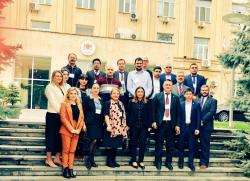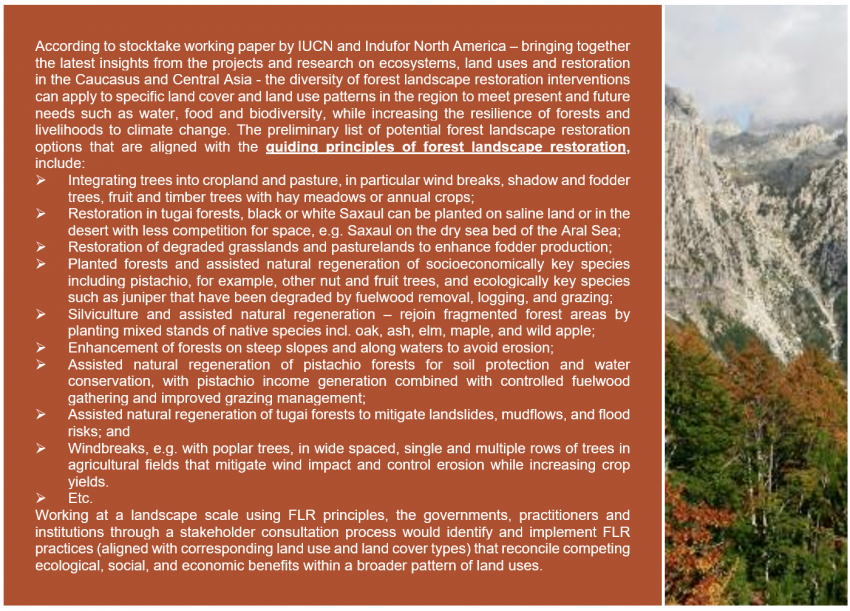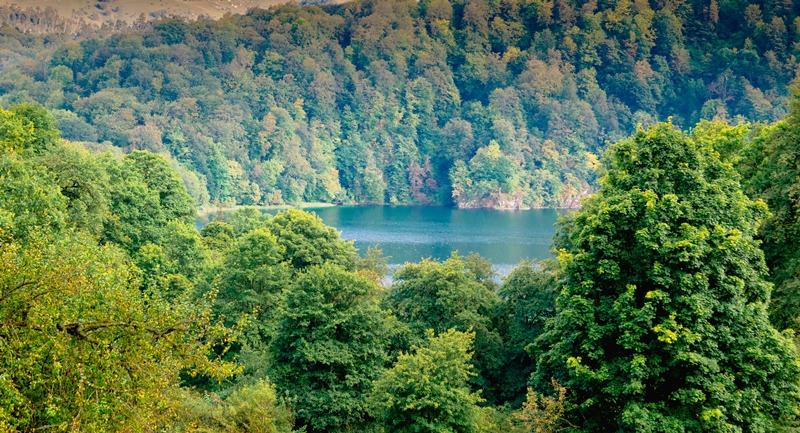Forest Landscape Restoration in Caucasus and Central Asia
Forest loss, land degradation and decline in ecosystems services is growing across the Caucasus and Central Asia region, resulting in loss of the biological and economic productivity of the land, decreases in environmental benefits, and a substantial negative impact on national economies. Yet, strong signs of commitment to restoring degraded landscapes and conserving biodiversity and natural resources are evidenced by the range of ongoing restoration efforts across the region as well as national expressions of interest to join the Bonn Challenge global restoration movement.

Photo: IUCN / Salome Begeladze
Last June (2018) in Astana, Kazakhstan the first Ministerial Roundtable on Forest Landscape Restoration and the Bonn Challenge in the Caucasus and Central Asia provided an ideal platform for regional leaders and decision-makers to make commitments towards forest landscape restoration (FLR). Armenia, Georgia, Kazakhstan, Kyrgyz Republic, Tajikistan and Uzbekistan pledged to bring over 2.5 million hectares into restoration under the Bonn Challenge by 2030. The countries also adopted the Astana Resolution, calling on the region to go beyond the 2.5 million hectares, and to strive for stronger regional cooperation on FLR.
 Photo: IUCN
Photo: IUCN
The Caucasus and Central Asia (CCA) region includes Armenia, Azerbaijan, Georgia, Kazakhstan, Kyrgyz Republic, Tajikistan, Turkmenistan, and Uzbekistan.
A little background
After the collapse of the Soviet Union, the 1990’s saw a decline in economic opportunities and energy deficiency. As a result, agriculture production intensified as well as livestock and dependency on forest resources for commercial and fuelwood use. Consequently, CCA countries experienced forest and habitat loss and land degradation. Furthermore, the biophysical characteristics of the region and the impacts of climate change – low or extreme rainfall and heat/cold stresses – exacerbate the environmental challenges.
A wide variety of biophysical, socio-economic and political challenges exist under the complex management systems of landscapes in the CCA. The main drivers of degradation and deforestation in the region are linked to soil erosion, soil fertility depletion, fuelwood collection, salinisation, intensive tillage, overgrazing, lack of effective pasture management techniques, illegal logging, mining, unsustainable cropping practices, expansion of agriculture, vegetation changes in rangelands, cultivation of sloping areas, unsustainable harvesting of timber, conversion of grasslands for agriculture, expanding networks of irrigation channels in steppe ecosystems and wildfires.
Engaging further with forest landscape restoration
IUCN supports the scaling up of FLR efforts in the CCA region. Building on the outcomes of the June 2018 Astana Ministerial Roundtable, a capacity development workshop on FLR and a restoration opportunities assessment in the CCA was organised by IUCN, in collaboration with the Ministry of Environmental Protection and Agriculture of Georgia and with support from the government of Germany.
A workshop was held in Tbilisi, Georgia in November 2018 and provided the countries’ representatives with FLR knowledge and tools to further define national and regional priorities, and identify next steps in line with ongoing restoration initiatives in the region. The participants included representatives of the ministries and government departments from CCA countries, and was led by IUCN with the guest speakers from the World Bank, ICRAF, and FAO-UNECE.
At the workshop, Deputy Minister, Nino Tandiashvili, from the Ministry of Environmental Protection and Agriculture of Georgia recognised the common challenges in the region and highlighted the importance of the forest ecosystems for local livelihoods in Georgia - “… forest resources such as timber and non-timber forest products contribute to a significant portion of many families’ annual household income. Thus, forest degradation aspects have negative impacts on local communities in the country. Restoring forests and forest landscapes is an important step in regaining health and functionality of these ecosystems”.
Guest speaker Paola Agostini of the World Bank, motivated participants by assuring them that, “landscape restoration is doable” as she provided examples from several successful cases across the world. However, the scaling up the FLR opportunities is currently still limited by a range of uncertainties and knowledge gaps (i.e. financial resourcing opportunities, tracking progress, technical capacity) that hinder the ability to identify landscape restoration opportunities and options suitable to local contexts, ecosystems and land uses. There is a need for improved knowledge to help make informed decisions and unlock the full potential of FLR.
 Photo: IUCN
Photo: IUCN
What have we learned?
- In support of the Astana Resolution to reinforce regional cooperation on FLR, the “30x30 Initiative” (to bring 30 million hectares into restoration by 2030 in the Eastern Europe, Caucasus and Central Asia) was discussed in support of the Bonn Challenge as a mechanism to receive international and regional exposure to regional and domestic priorities and projects, to access technical and financial support and benefit from shared knowledge and peer experiences. This initiative was further discussed at the Global Landscape Forum this December 2018 in Bonn, Germany. CCA countries are eager to engage and strengthen regional partnerships and reinforce regional cooperation, in particular through policy dialogues, FLR joint programming, mobilising international and national financing, and more.
- Global Environment Facility current investment cycle GEF7, provides vast opportunities to access funding for restoration by linking FLR and the sustainable production systems and ecosystem services they depend on – as well as recognising the importance of the FLR approach in Central Asia’s degraded rangelands and steppe forests, which will result in significant domestic, regional and global environmental benefits and enhance the wellbeing of resilient societies to climate change. The countries will need to seek different blends of public and private funding. This is a worthwhile effort for countries to fully reap the benefits of all the funding opportunities that are pertinent to large-scale FLR implementation in the region.
- FLR happens on the ground, but achieving landscape-scale transformational change depends on commitment from all levels. Unlocking full potential requires the identification of opportunities across degraded and deforested landscapes. This entails national, regional and international efforts to work with countries and partners to initiate, facilitate, and support regional, national, and subnational FLR opportunities assessments in the CCA Region. For example, a Restoration Opportunities Assessment Methodology supports decision making on the relevance and feasibility of potential landscape restoration interventions across an assessment area, generating knowledge on landscape restoration interventions and associated public goods and services and business products, to stimulate public and private investments in FLR.
- Taking stock of progress is an opportunity for knowledge sharing and developing targeted support to fill political, technical and financial gaps for scaling up FLR. The Bonn Challenge Barometer – Progress Tracking Protocol offers the latest methodologies for improved tracking and reporting against multiple connected national environmental and development objectives and international commitments related to restoration (e.g. Bonn Challenge, LDN Targets, CBD Aichi Targets, and UNFCCC NDCs).
The collaborative efforts of the participants and their commitments to FLR endowed the workshop with restoration knowledge, expertise and enthusiasm. However, the journey ahead for FLR implementation continues, and IUCN looks forward to continuing its support for countries in the CCA.
For more information, please see FOREST LANDSCAPE RESTORATION: TRANSFORMING LANDSCAPES AND LIVELIHOODS IN THE CAUCASUS AND CENTRAL ASIA
For more information, contact:
Salome Begeladze, IUCN Global Forest and Climate Change Programme
Boris Erg, IUCN Regional Office for Eastern Europe and Central Asia

